There are over 800 worldwide, but only 7 species of tree frogs in Pennsylvania. Technically, living in trees isn’t what defines a tree frog. Real tree frogs have a specialized bone in their toes that is shaped like a claw and specialized toe pads that allow them to climb trees. Species that live at ground level have lost these toe pads.
Pennsylvania is home to 16.8 million acres of forest land, and has many different species of wildlife living within these habitats. In addition, Pennsylvania has 83,184 miles of streams and rivers as well as more than 4,000 lakes, reservoirs, and ponds. Since tree frogs live in trees and must be in close proximity to water, this creates a large home for them.
With all that being said, let’s have a look at Pennsylvania’s tree frogs!
7 types of tree frogs in Pennsylvania
The 7 tree frogs in PA (Pennsylvania) are the northern cricket frog, spring peeper, eastern gray tree frog, mountain chorus frog, western chorus frog, upland chorus frog and the New Jersey chorus frog.
1. Northern Cricket Frog
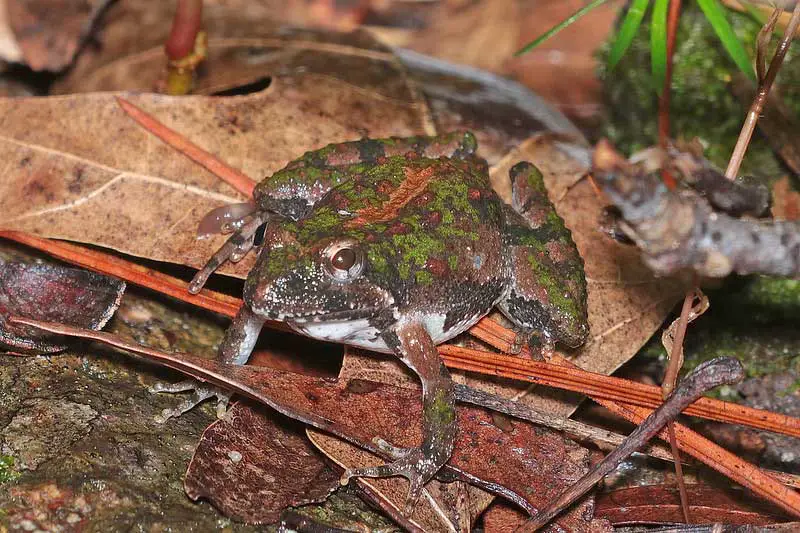
Scientific Name: Acris crepitans
The Northern Cricket Frog, a small species and often considered one of Pennsylvania’s tree frogs, measures only five-eighths to 1 3/8 inches long. It’s found in Southeastern Pennsylvania. Its range extends from Long Island to the Florida panhandle, and west to the outskirts of Texas.
Unlike most tree frogs, the cricket frog has warty, rough skin similar to a toad. Its body is gray with a black stripe on each side. It also has a dark triangular shape on its head.
Cricket frogs can be difficult to spot because its coloring allows it to camouflage itself in the grass near the shoreline.
It prefers shallow ponds and small streams when it takes to the water. It spends most of its time on the shoreline, preferring vegetated areas that offer lots of cover.
The cricket frog’s long legs allow it to make big leaps. It uses this ability to catch insects, often in mid-air.
The male frog calls using a throat pouch. The sound is similar to a cricket, which is likely where the frog gets its name. The call starts slowly and speeds up, lasting for 20-30 individual beats.
2. Spring Peeper
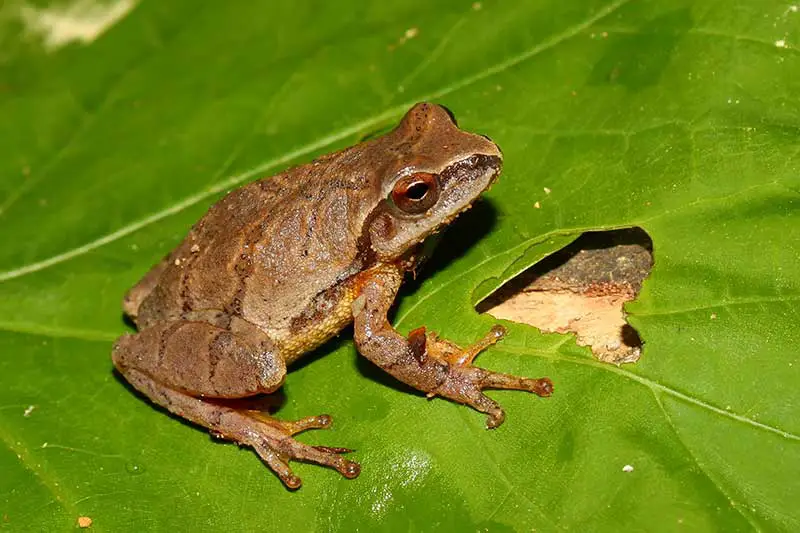
Scientific Name: Pseudacris crucifer
The Spring Peeper is thought to be the most common tree frog in Pennsylvania, even though it is rarely spotted. It’s slightly smaller than the cricket frog, with adults reaching three-fourths to 1 1/4 inches long.
It’s found throughout Pennsylvania. Its range extends from Canada through the eastern third of the United States.
It’s found near permeant bodies of water. It can live near temporary bodies of water, but it will not be found near polluted waters. It prefers dense wooded areas, where it makes its home in the trees.
The top of its body can be tan, light brown, or gray. The underside will be lighter than the body. It has a dark V shape on its back, and bands of color on its legs.
Spring peepers hibernate during the winter months, often beneath logs or loose bark. It reappears in March, and signals the beginning of spring.
When the peeper begins to call, it does so both day and night. The call signals the beginning of spring, and often comes with spring rains. As the season goes on, the peepers only call at night.
Instead of calling individually, peepers create a chorus. The call is described as a high whistle.
The peeper isn’t a picky eater. It eats small invertebrates, including flies, grubs, and ants.
3. Eastern Gray Treefrog
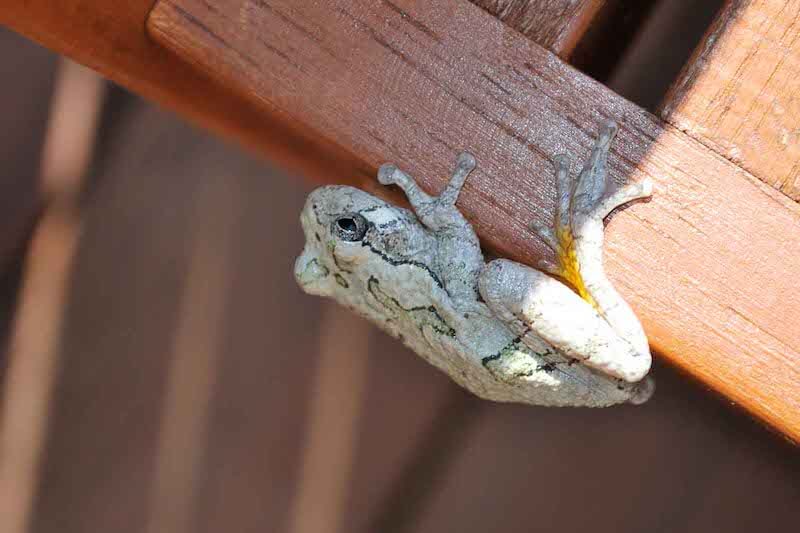
Scientific Name: Hyta versicolor
The Eastern Gray Treefrog is larger, measuring 1 1/4 to two inches. As the name suggests, it is often gray in color. It can also be green or brown. it has a dark blotch on its back, which makes it easily recognizable. Its underside is are bright yellow or orange. The skin will be rough and warty.
It’s found throughout nearly all of Pennsylvania. When it comes to the Allegheny Mountains, sightings are questionable. It extends through most of the Eastern U.S., excluding Maine and southern Florida.
Gray tree frogs prefer small trees or shrubs near or growing from permeant bodies of water. It stays in the trees the majority of the time. At night, it climbs down to breed and call.
Calling begins with the frogs high in the trees. Eventually, it moves down to ground level near the breeding site. They call most often in spring and early summer at twilight.
4. Mountain Chorus Frog
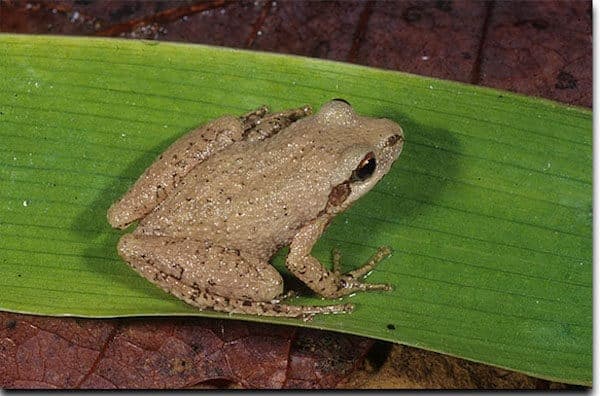
Scientific Name: Pseudacris brachyphona
The mountain chorus frog is heard more often than it is seen. These nocturnal frogs grow to 1-1 1/4 inches long and actually leap very well. In fact, leaping is their preferred method of movement.
It’s found west of the Allegheny Mountains in the southern part of the state, with Pennsylvania as its northernmost range. It’s found from southern Ohio down to Alabama.
It can be light brown or green. The underside is yellow. It has two dark stripes on its back that curve inward, creating an x pattern. It also has a stripe over each eye.
The chorus frog does have pads on its feet, but they are much smaller than those of the peeper and eastern tree frog.
The mountain chorus frog prefers forested or mountainous areas. Its water sources are creeks and mountain streams. However, it can be found far from water as well.
Mountain chorus frogs begin calling with the spring rains. They call night and day, usually near the water hidden in grass or leaves. The mountain chorus frog has a high pitch squeak.
They generally feed on the ground, catching insects from among weeds and shrubs.
5. Western Chorus Frog
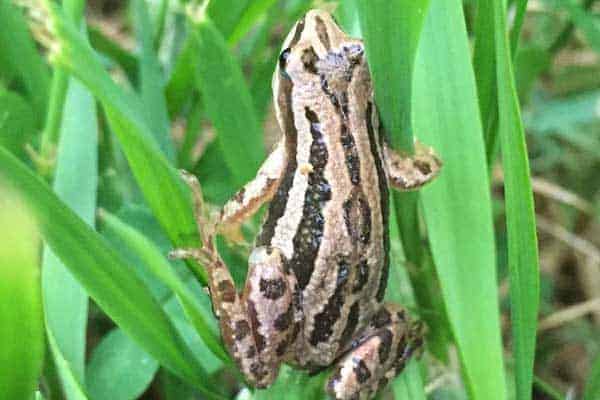
Scientific Name: Pseudacris triseriata
The western chorus frog grows to 3/4-1 1/2 inches in length. It’s difficult to spot outside of breeding season. It is nocturnal and spends most of its time hidden when not seeking a mate.
Its skin is green, gray, light brown, or tan. Its stomach is an off-white color. It has three stripes on its back, and one on each side near the nostrils.
As the name suggests, it can be found west of the Allegheny Mountains. You’ll find it between the mountain range and the Ohio state line.
Its habitat is very versatile and includes grasslands, swamplands, and agricultural areas. Chorus frogs can thrive on wet or dry land. They take shelter under large rocks, tall grass, or in abandoned burrows during the winter months.
Western chorus frogs breed near water sources and begin calling early in the year, often before the ice has melted. The call is one to two seconds long and repeated several times. The breeding season lasts from February to June.
They eat small insects and other invertebrates, including insect larva.
6. Upland Chorus Frog

Scientific Name: Pseudacris feriarum
The upland chorus frog is very similar to the mountain chorus frog. They are found around the Allegheny Mountain area. They are relatively small, at 3/4 – 1 1/2 inches.
Coloring and markings vary. They are typically gray, green, or light brown. They have a dark stripe down both sides of the body. The legs have dark spots or bars.
They prefer woodlands, marshes, and meadows. They breed near water, and can often be found in the water during the breeding season.
7. New Jersey Chorus Frog

Scientific Name: Pseudacris kalmi
The new jersey chorus frog is similar to the western and upland chorus frogs. Adults grow to 3/4 – 1/12 inches long. It prefers a similar habitat, living in dense vegetation in woods, marshes, and meadows.
It’s only found in Montgomery and Bucks counties.
It is gray or tan. It has a dark stripe on each side that runs through the eyes and down to the groin.



